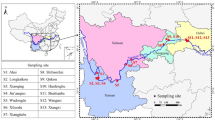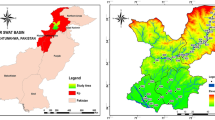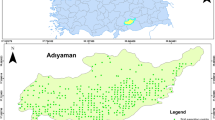Abstract
The distribution, potential ecological hazards, and homologous relativity of heavy metals in the water-level fluctuating zone (WLFZ) of the Yangtze River within the Wanzhou Section (YRWS) were investigated. The heavy metal content (Cd, Cu, Cr, and Ni) of the surface soil was analysed via atomic absorption spectroscopy. The potential ecological hazards of the heavy metals in the WLFZ soil of YRWS were also evaluated using the classical Lars Hakanson potential ecological risk index method, and the relevance of the heavy metals in the soil was investigated. The average Cd, Cr, Cu, and Ni concentrations were 2.14, 35.43, 18.47, and 34.52 mg/kg, respectively. The Cd and Ni contents in the soil exceeded the reference values in China by about 28.6- and 1.1-fold, respectively. Correlation analysis shows a highly significant correlation between Cd and Cr, indicating that their sources were the same. The major pollutant was Cd, which reached a very strong ecological hazard level. The potential ecological risk individual coefficients of the four heavy metals were ranked as follows: Cd (802.61) > Cu (4.43) > Ni (4.15) > Cr (1.23). The risk levels in the different regions were ranked as follows: Zhuxi River > mainstream > Mixi valley. The potential ecological risk in the WLFZ within the Zhuxi River was the highest among the regions and poses a certain health risk.
Similar content being viewed by others
Explore related subjects
Discover the latest articles, news and stories from top researchers in related subjects.Avoid common mistakes on your manuscript.
Introduction
The eco-environment in the Three Gorges Reservoir Area (TGRA) in China has received considerable attention after June 12, 2003, when its water level reached 135.4 m and the Three Gorges Hydropower Station began to generate electricity [1, 2]. However, after the construction of the Three Gorges dam, serious pollution problems have arisen in Wanzhou, a city in the centre of the TGRA, because of the more than 2,000 sewage drains flowing out to the upper Yangtze River every year [3, 4].
Heavy metals are persistent environmental pollutants [5] because they are non-biodegradable and can readily accumulate to toxic levels in water, soil, and biota [6, 7]. After their release into the environment, heavy metals are first rendered water soluble through oxidation processes and are then adsorbed and accumulate on the water-level fluctuating zone (WLFZ) soil until they eventually reach the bottom sediments [3, 8]. In addition, environmental pollution by heavy metals of anthropogenic origin can be caused by improper farming activities, such as irrigation using contaminated wastewater or the excessive use of fertilisers and insecticides on WLFZ soil [9, 10].
In the present study, the contents of typical pollutants (Cd, Cr, Cu, and Ni) in soil were analysed, and the ecological risk of the metal contaminants was assessed using the Hakanson potential ecological risk index. The objective of the present study is to evaluate the soil quality in the WLFZ of the Yangtze River within the Wanzhou Section (YRWS) for the environmental protection of the Three Gorges Area.
Materials and Methods
Sampling and Preparation
Samples were collected from dry beds during the dry season. A total of 36 soil samples (depth <20 cm) were collected during the summer season (August 2010) in the WLFZ of the Yangtze River (Wanzhou Section) and in its two branches, the Zhuxi River and Mixi valley, according to a systematic sampling scheme (Fig. 1). At present, both are seriously polluted. Each soil sample, consisting of 5–10 subsamples, was randomly collected from the surroundings of each site and homogenised to form a representative sample [11, 12]. The composite soils were stored in sealed polyethylene packages at 4°C after being air-dried at room temperature and sieved through a 1-mm mesh. The soil samples were digested in a 3:1 HNO3/HClO4 (v/v) solution using a MARS Xpress microwave digestion instrument (CEM, USA). The sample digests were filtered, and the volume was adjusted to 50 ml with ultrapure water. The samples were then stored in polyethylene containers at +4°C prior to analysis.
The Cd, Cu, Cr, and Ni concentrations in the digested solution were determined using a flame atomic absorption spectrophotometer (Analyst 200, PerkinElmer, Shelton, USA). All laboratory glassware were soaked in 1:4 HNO3 for 24 h and then rinsed prior to use. The reagents for the trace metal element analysis were of superior grade or higher. The solutions were prepared using ultrapure water.
The standard reference materials obtained from the Centre of National Standard Reference Material of China were analysed as part of the quality assurance and quality control procedures. Satisfactory recoveries were obtained for Cd (93–98%), Cr (98–103%), Cu (96–101%), and Ni (96–103%).
Data Analysis and Evaluation
The potential ecological risk index method, which is based on the characteristics of a heavy metal and its environmental behaviour, was advanced by the Swedish scholar Lars Hakanson [13, 14], according to the characteristics of heavy metal and its environmental behaviour. The potential ecological risk index method is an approach to evaluate the heavy metal contamination from the perspective of sedimentology. It not only considers the heavy metal level in the soil, but also associates the ecological and environmental effects with toxicology and evaluates the pollution level using the comparable and equivalent property index grading method. The potential ecological risk index is related to the individual pollution coefficient, the heavy metal toxicity response coefficient, and the potential ecological risk individual coefficient, and is expressed as follows[13]:
where E i is the potential ecological risk individual coefficient and T i is the toxicity response coefficient of a certain kind of metal toxicity using the standard heavy metal toxicity coefficient developed by Hakanson as a reference. The heavy metal toxicity level is ranked in the order, Cd > Cu > Ni > Cr, and the toxicity coefficients of Cd, Cu, Ni, and Cr are 30, 5, 3, and 2, respectively. f i is the individual pollution coefficient, C i is the actual observed value of heavy metals in surface soil, and B i is a relative ratio, which is obtained from the background values of soil heavy metals in China [15]. The detailed grading standard of heavy metal individual pollution coefficients and pollution ecological risk coefficients are listed in Table 1.
Results and Analysis
Total Heavy Metal Contents
The descriptive statistics of the metal levels in the WLFZ of the YRWS and its branches (Mixi valley and Zhuxi River) are summarised in Table 2, which show a distinct change in the heavy metal contents among the soil samples. The Cd, Cr, Cu, and Ni contents varied between 1.26 and 3.60, 23.71 and 46.90, 11.23 and 62.03, and 19.00 and 52.66 mg/kg, respectively, with an average content of 2.14, 35.43, 18.47, and 34.52 mg/kg, respectively. The components in the soil samples were arranged in the following decreasing order based on the mean content: Cr > Ni > Cu > Cd. The soil background values of Sichuan and China [15] were used as the reference values. The Cd and Ni contents in the soil samples exceeded the reference values in China by about 28.6- and 1.1-fold, respectively, and were 26.8- and 1.4-fold higher than the soil background values of Sichuan, respectively. These results clearly demonstrate an anthropogenic contribution.
The heavy metal spatial distributions in the mainstream and in the two major tributaries of the Yangtze River within the Wanzhou Section are shown in Table 2. The total metal contents were ranked in the following decreasing order: for Cd and Cr, Zhuxi River > mainstream > Mixi valley; for Cu, mainstream > Zhuxi River > Mixi valley; and for Ni, Mixi valley > Zhuxi River > mainstream. The maximum Cd and Cr values in the soil, which reached 3.6 and 46.9 mg/kg, respectively, were found in the WLFZ of the Zhuxi River. The average Cd, Cr, Cu, and Ni contents in the WLFZ of the Zhuxi River were 3.04, 41.81, 18.65, and 34.30 mg/kg, respectively, with the Cd and Cr contents higher than those in other regions. The Zhuxi River has a basin area of 228.8 km2 and is an important tributary of the Yangtze River. Approximately 1.7 million people from the area of the Three Gorges Project live around this river. A large amount of wastewater was discharged into the Zhuxi River, and the land in its WLFZ was irrationally utilised for farming using significant amounts of fertilisers and insecticides. Furthermore, a check dam was built in 2008, which slowed the water flow and inhibited the diffusion of contaminants. The distribution of these elements indicates the major role of human activities as the pollutant source [16, 17].
Correlations between Heavy Metals
Heavy metals in soils are mainly the original contents of rocks and parent materials and may also result from various soil formation processes and anthropogenic factors, such as contamination due to human activities. Correlations between homologous heavy metals exist, and these can be used to determine whether the sources of these heavy metals are the same [18, 19].
If there is a significant correlation between the elements, the probability that they came from the same pollution source is high, and such source may result from the combined pollution imposed by human activities or by natural factors (geochemical sources) [20, 21].
Table 3 shows the correlation coefficient matrix and lists the Pearson’s product moment correlation coefficient. Weak direct correlations were found between Cd and Cu (r = 0.230), Cd and Ni (r = 0.002), Cr and Cu (r = 0.155), Cr and Ni (r = −0.156), and Cu and Ni (r = 0.117), which were all at the 0.01 level. However, the Cd values show a very significant direct correlation with Cr (r = 0.739), suggesting that both metals came from the same sources (pesticides, fertilisers, and so on) and followed a similar accumulation pattern.
Potential Ecological Risk Assessment
The potential risk of heavy metals in the WLFZ soil of the Yangtze River was assessed using the potential ecological risk index method of Hakanson. The risk index (RI) represents the sensitivity of various organisms to toxic substances and illustrates the potential ecological risk caused by heavy metal contamination in soil. In the YRWS soil, the Cd content reached the strong pollution level, whereas the other elements had lower potential ecological risk coefficients (Table 4).
The potential ecological risk levels (hazard indices) of the four kinds of heavy metals in the YRWS were ranked in the following order: Cd (802.61) > Cu (4.43) > Ni (4.15) > Cr (1.23). The potential ecological risk levels in the different regions were ranked in the following order: Zhuxi River > mainstream > Mixi valley. The WLFZ within the Zhuxi River had the highest potential ecological risk and was judged a health risk to the population living in the area. Evidently, actions are needed to alleviate the environmental pressures and to prevent further heavy metal accumulation. Some measures recommended include the reduction of urban wastewater discharge into the tributaries and the pre-purification of wastewater to meet the national standard prior to discharge. Farming should also be regulated in the WLFZ within the TGRA because it can cause additional amounts of fertilisers, pesticides, heavy metals, oil residues, garbage, sewage, and so on to be introduced into the soil and water.
Conclusions
-
1.
The investigation of 36 soil samples from the mainstream and tributaries (Zhuxi River and Mixi valley) of the YRWS reveals a certain accumulation of Cd, Cr, Cu, and Ni. The Cd, Cr, Cu, and Ni contents varied between 1.40 and 3.60, 23.71 and 46.90, 11.23 and 62.03, and 19.00 and 52.66 mg/kg, respectively, with an average content of 2.14, 35.43, 18.47, and 34.52 mg/kg, respectively. The Cd and Ni contents in the WLFZ soils in the YRWS exceed the soil background values in China by 28.6- and 1.1-fold, respectively, clearly demonstrating an anthropogenic contribution.
-
2.
The heavy metal distributions in the YRWS are in the following decreasing order: for Cd and Cr, Zhuxi River > mainstream > Mixi valley; for Cu, Zhuxi River > Mixi valley > mainstream; and for Ni, Mixi valley > Zhuxi River > mainstream.
-
3.
The observed statistically significant (P = 0.01) direct correlation between Cd and Cr suggests that the heavy metal pollution in the Yangtze River WLFZ within the Wanzhou Section originates from human activities
-
4.
The potential ecological risk levels in the different regions were ranked in the following order: Zhuxi River > mainstream > Mixi valley. The potential ecological risk in the WLFZ within the Zhuxi River was the highest and may pose certain risks to the health of the people in that area.
References
Bai SB, Wang J, Lü GN, Zhou PG, Hou SS, Xu SN (2010) GIS-based logistic regression for landslide susceptibility mapping of the Zhongxian segment in the Three Gorges area, China. Geomorphology 115:23–31
Zhang J, Zhengjun L, Xiaoxia S (2009) Changing landscape in the Three Gorges Reservoir Area of Yangtze River from 1977 to 2005: land use/land cover, vegetation cover changes estimated using multi-source satellite data. Int J Appl Earth Obs Geoinf 11:403–412
Fu C, Guo J, Pan J, Qi J, Zhou W (2009) Potential ecological risk assessment of heavy metal pollution in sediments of the Yangtze River within the Wanzhou Section, China. Biol Trace Elem Res 129:270–277
Muller B, Berg M, Yao ZP, Zhang XF, Wang D, Pfluger A (2008) How polluted is the Yangtze river? Water quality downstream from the Three Gorges Dam. Sci Total Environ 402:232–247
Qin YY, Leung CKM, Leung A, Wu SC, Zheng JS, Wong MH (2010) Persistent organic pollutants and heavy metals in adipose tissues of patients with uterine leiomyomas and the association of these pollutants with seafood diet, BMI, and age. Environ Sci Pollut Res 17:229–240
Kumar Sharma R, Agrawal M, Marshall F (2007) Heavy metal contamination of soil and vegetables in suburban areas of Varanasi, India. Ecotoxicol Environ Safety 66:258–266
Zhang W, Feng H, Chang J, Qu J, Xie H, Yu L (2009) Heavy metal contamination in surface sediments of Yangtze River intertidal zone: an assessment from different indexes. Environ Pollut 157:1533–1543
Doong R, Lee S, Lee C, Sun Y, Wu S (2008) Characterization and composition of heavy metals and persistent organic pollutants in water and estuarine sediments from Gao-ping River, Taiwan. Mar Pollut Bull 57:846–857
Mansour SA, Belal MH, Abou-Arab AAK, Gad MF (2009) Monitoring of pesticides and heavy metals in cucumber fruits produced from different farming systems. Chemosphere 75:601–609
Wu W, Xie DT, Liu HB (2009) Spatial variability of soil heavy metals in the three gorges area: multivariate and geostatistical analyses. Environ Monit Assess 157:63–71
Sun Y, Zhou Q, Xie X, Liu R (2010) Spatial, sources and risk assessment of heavy metal contamination of urban soils in typical regions of Shenyang, China. J Hazard Mater 174:455–462
Wang W, Massey Simonich SL, Xue M, Zhao J, Zhang N, Wang R, Cao J, Tao S (2010) Concentrations, sources and spatial distribution of polycyclic aromatic hydrocarbons in soils from Beijing, Tianjin and surrounding areas, North China. Environ Pollut 158:1245–1251
Hakanson L (1980) An ecological risk index for aquatic pollution control. A sedimentological approach. Water Res 14:975–1001
Liu J, Li Y, Zhang B, Cao J, Cao Z, Domagalski J (2009) Ecological risk of heavy metals in sediments of the Luan River source water. Ecotoxicology 18:748–758
CEPA (1990) Elemental background values of soils in China. Environ Sci Press of China, Beijing
Li S, Zhang Q (2010) Spatial characterization of dissolved trace elements and heavy metals in the upper Han River (China) using multivariate statistical techniques. J Hazard Mater 176:579–588
Chen T, Liu X, Zhu M, Zhao K, Wu J, Xu J, Huang P (2008) Identification of trace element sources and associated risk assessment in vegetable soils of the urban-rural transitional area of Hangzhou, China. Environl Pollut 151:67–78
Khan S, Cao Q, Zheng YM, Huang YZ, Zhu YG (2008) Health risks of heavy metals in contaminated soils and food crops irrigated with wastewater in Beijing, China. Environ Pollut 152:686–692
Dragovic S, Mihailovic N, Gajic B (2008) Heavy metals in soils: distribution, relationship with soil characteristics and radionuclides and multivariate assessment of contamination sources. Chemosphere 72:491–495
De Wolf H, Rashid R (2008) Heavy metal accumulation in Littoraria scabra along polluted and pristine mangrove areas of Tanzania. Environ Pollut 152:636–643
Terzano R, Spagnuolo M, Vekemans B, De Nolf W, Janssens K, Falkenberg G, Fiore S, Ruggiero P (2007) Assessing the origin and fate of Cr, Ni, Cu, Zn, Pb, and V in industrial polluted soil by combined microspectroscopic techniques and bulk extraction methods. Environ Sci Technol 41:6762–6769
Acknowledgements
This research was supported by the Construction of Research and Innovation Teams of the Educational Commission of Chongqing, China (no. 2010-16), and the Key Project of Chongqing Three Gorges University (contract no. 10ZD-15).
Author information
Authors and Affiliations
Corresponding author
Rights and permissions
About this article
Cite this article
Lin, J., Fu, C., Zhang, X. et al. Heavy Metal Contamination in the Water-Level Fluctuating Zone of the Yangtze River within Wanzhou Section, China. Biol Trace Elem Res 145, 268–272 (2012). https://doi.org/10.1007/s12011-011-9179-6
Received:
Accepted:
Published:
Issue Date:
DOI: https://doi.org/10.1007/s12011-011-9179-6





